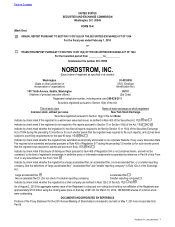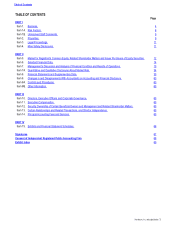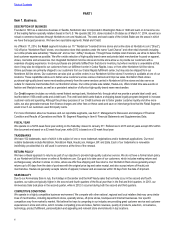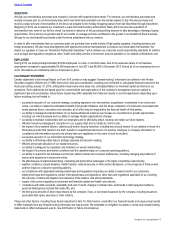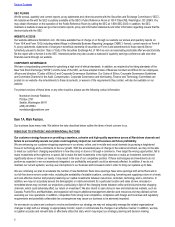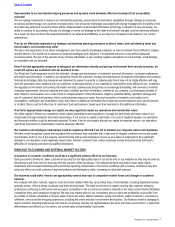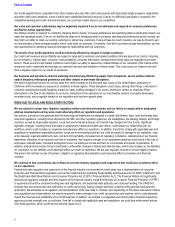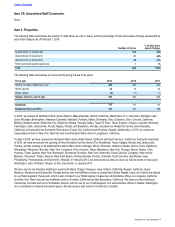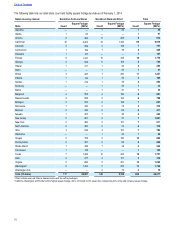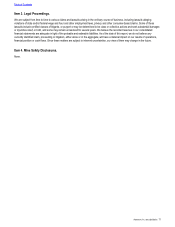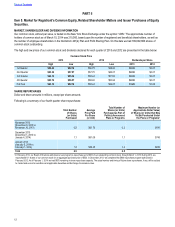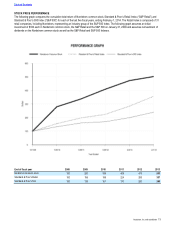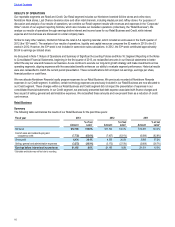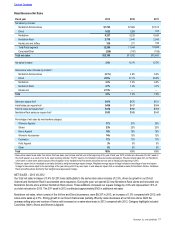Nordstrom 2013 Annual Report Download - page 7
Download and view the complete annual report
Please find page 7 of the 2013 Nordstrom annual report below. You can navigate through the pages in the report by either clicking on the pages listed below, or by using the keyword search tool below to find specific information within the annual report.
Nordstrom, Inc. and subsidiaries 7
Improvements to our merchandise buying processes and systems could adversely affect our business if not successfully
executed.
We are making investments to improve our merchandise planning, procurement and allocation capabilities through changes in personnel,
processes and technology over a period of several years. If we encounter challenges associated with change management, the ability to hire
and retain key personnel involved in these efforts, implementation of associated information technology or adoption of new processes, our
ability to continue to successfully execute our strategy or evolve our strategy as the retail environment changes could be adversely affected.
As a result, we may not derive the expected benefits to our sales and profitability, or we may incur increased costs relative to our current
expectations.
If we do not effectively implement our strategic and business planning processes to attract, retain, train and develop talent and
future leaders, our business may suffer.
We rely on the experience of our senior management, who have specific knowledge relating to us and our industry that is difficult to replace,
and the talents of our workforce to execute our business strategies and objectives. If unexpected turnover occurs without adequate
succession plans, the loss of the services of any of these individuals, or any resulting negative perceptions of our business, could damage
our reputation and our business.
Even if we take appropriate measures to safeguard our information security and privacy environment from security breaches, we
could still expose our customers and our business to risk.
Our Retail and Credit segments involve the collection, storage and transmission of customers’ personal information, consumer preferences
and credit card information. In addition, our operations involve the collection, storage and transmission of employee information and company
financial and strategic data. Any measures we implement to prevent a security or cybersecurity threat may not be totally effective and may
have the potential to harm relations with our customers or decrease activity on our websites by making them more difficult to use. In addition,
the regulatory environment surrounding information security, cybersecurity and privacy is increasingly demanding, with new and constantly
changing requirements. Security breaches and cyber incidents and their remediation, whether at our company, our third-party providers or
other retailers, could expose us to a risk of loss or misappropriation of this information, litigation, potential liability, reputation damage and
loss of customers’ trust and business, which could adversely impact our sales. Any such breaches or incidents could subject us to
investigation, notification and remediation costs, and if there is additional information that is later discovered related to such security breach
or incident, there could be further loss of customers’ trust and business, based upon their reactions to this additional information.
If we fail to appropriately manage our capital, we may negatively impact our operations and shareholder return.
We utilize capital to finance our operations, make capital expenditures and acquisitions, manage our debt levels and return value to our
shareholders through dividends and share repurchases. If our access to capital is restricted or our cost of capital increases, our operations
and financial condition could be adversely impacted. Further, if we do not properly allocate our capital to maximize returns, our operations,
cash flows and returns to shareholders could be adversely affected.
Our customer and employee relationships could be negatively affected if we fail to maintain our corporate culture and reputation.
We have a well-recognized culture and reputation that consumers may associate with a high level of integrity, customer service and quality
merchandise, and it is one of the reasons customers shop with us and employees choose us as a place of employment. Any significant
damage to our reputation could negatively impact sales, diminish customer trust, reduce employee morale and productivity and lead to
difficulties in recruiting and retaining qualified employees.
RISKS DUE TO ECONOMIC AND EXTERNAL MARKET FACTORS
A downturn in economic conditions could have a significant adverse effect on our business.
During economic downturns, fewer customers may shop for the high-quality items in our stores and on our websites as they may be seen as
discretionary and those who do shop may limit the amount of their purchases. This reduced demand may lead to lower sales, higher
markdowns and increased marketing and promotional spending. Deterioration of economic conditions and consumer confidence may also
adversely affect our credit customers’ payment patterns and delinquency rates, increasing our bad debt expense.
Our business could suffer if we do not appropriately assess and react to competitive market forces and changes in customer
behavior.
We compete with other national, regional, local and online retailers that may carry similar lines of merchandise, including department stores,
specialty stores, off-price stores, boutiques and Internet businesses. The retail environment is rapidly evolving with customer shopping
preferences continuing to shift online and we expect competition in the e-commerce market to intensify in the future as the Internet facilitates
competitive entry and comparison shopping. We may lose market share to our competitors and our sales and profitability could suffer if we
are unable to remain competitive in the key areas of price and value, fashion newness, quality of products, depth of selection, convenience,
fulfillment, service and the shopping experience, including the online and store environment and location. Our financial model is changing to
match customer shopping preferences, but if we do not properly allocate our capital between the store and online environment, or adjust the
effectiveness and efficiency of our stores, our overall sales and profitability could suffer.
Table of Contents

